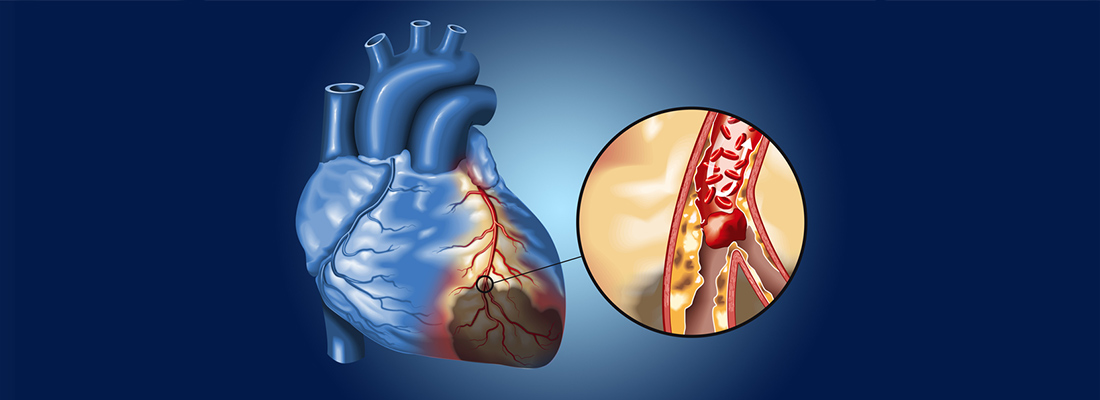Updated on June 20, 2024
Introduction
Whenever healthcare professionals discuss heart health, coronary thrombosis is often a highlighted medical condition. But what does it mean? Simply put, this is a condition that causes blood clots to form within the arteries of the heart. This clot can completely or partially block the blood flow to the heart muscle which causes serious health consequences.
What to Know About Coronary Thrombosis
Common Facts
- Coronary thrombosis is a condition in which an insufficient supply of blood and oxygen to the heart muscle occurs due to formation of blood clots in the coronary arteries. This could ultimately lead to parts of the heart muscle dying due to it not receiving enough blood or oxygen.
- In the United States, death cases accounting for about 80% due to sudden cardiac death.
- Symptoms may include shortness of breath, severe dizziness, severe chest pain, and pain originating from the chest and down the left arm.
- Risk factors include a family history, obesity, diabetes, smoking, hypertension.
- Appropriate medication is used to control and manage symptoms. In more severe conditions, cardiac specialists suggest surgical interventions like coronary artery bypass grafting or angioplasty.
- To prevent future incidents and complications, adopting healthy lifestyles such as maintaining a healthy weight, quitting smoking, and regular exercise are recommended.
What is Coronary Thrombosis?
Coronary thrombosis is a life-threatening condition that occurs when blood clot formation occurs in the coronary arteries (blood vessels carrying oxygenated blood to the heart muscle). It can have dire consequences such as heart failure and sudden cardiac death. This condition is a major contributor to Acute Coronary Syndrome (ACS), a collection of conditions characterized by the abrupt reduction in blood flow to the heart muscle, which results in symptoms of sudden severe chest pain, dyspnea, and potential cardiac damage.
The Correlation Between Coronary Thrombosis and Acute Coronary Syndrome
The term “Acute Coronary Syndrome (ACS)” refers to a cluster of medical conditions which is associated with reduced flow of blood to the heart. Myocardial infarction is one of the most common conditions caused by coronary thrombosis. Studies on ACS suggest significant insights to the management and treatment of this condition, underlining the importance of immediate medical intervention. Let’s dig deeper into the relationship between Acute Coronary Syndrome (ACS) and Coronary Thrombosis.
Acute Coronary Syndrome (ACS) is an umbrella term that encompasses a spectrum of clinical presentations, ranging from unstable angina to myocardial infarction (heart attack), all of which are primarily due to sudden myocardial ischemia. Myocardial ischemia occurs when blood flow to the heart muscle is decreased, which can lead to heart tissue damage or death.
Coronary Thrombosis is a critical event in the development of ACS. It involves the formation of a blood clot within the coronary arteries. Coronary arteries are the main arteries that supply oxygenated blood to the heart muscle. If a clot forms and obstructs the artery, it can significantly reduce or completely stop blood flow, leading to ischemia.
The process often begins with the rupture or erosion of atherosclerotic plaque, which is a build-up of fatty deposits on the arterial walls. When a plaque ruptures, platelets and other components of the blood adhere to the site and form a thrombus (clot). This thrombus can either partially or completely block the coronary artery.
Is Coronary Thrombosis a Heart Attack?
The answer is a bit complicated. There are multiple complex cardiac events intertwined in a heart attack. A heart attack can be caused by coronary thrombosis. When the blood supply to the muscles of the heart is insufficient, this causes damage and ultimately death of the heart tissue, also known as myocardial infarction (MI) or heart attack. This can often be caused by blockage of one of the coronary arteries due to blood clot formation.
Symptoms
The signs and symptoms of coronary thrombosis can include chest pain, pain originating from the chest that moves towards arms, neck, back, jaw, or stomach, causing nausea, lightheadedness, shortness of breath, sweating, vertigo, and fainting. These symptoms indicate a medical emergency and immediate medical assistance is essential.
Risk Factors: Major Precursor
The following are various factors that increase the risk of developing ACS and thrombosis, including:
- High Cholesterol: High levels of LDL (Low Density Lipoprotein); cholesterol can accumulate and cause formation of plaque in the arteries that increases the risk of formation of clots.
- Smoking: Frequent usage of tobacco damages blood vessels and promotes formation of blood clots.
- Hypertension: High blood pressure puts stress on the arteries that make arteries weaker and damaged, and ultimately causes clot formation.
- Obesity: Excess weight puts stress on the heart muscle and raises the risk of developing other risk factors such as high blood pressure and diabetes.
- Diabetes: If diabetes is poorly managed it can lead to damage to blood vessels and foster clot formation.
Preventive Management
While some risk factors such as age and family history are beyond control for coronary thrombosis and ACS, but there are some preventive steps for individuals to reduce their risk:
- Smoking Cessation: Quitting smoking minimizes the risk of the formation of blood clots and other cardiovascular complications.
- Healthy Lifestyle: Managing and controlling blood pressure level and cholesterol levels through a healthy diet including lean proteins, whole grains, fruits, and vegetables can help.
- Regular Exercise: Physical activity regularly strengthens the heart and enhances overall cardiovascular health.
- Medication: To control or prevent coronary thrombosis, some physicians prescribe medications such as blood thinners, statins and aspirin. They reduce the clot formation process that leads to reducing the risk.
Diagnosis and Treatment:
Clinical evaluation, ECG (electrocardiogram), and blood tests to identify heart proteins that leak into blood stream due to heart tissue damage, is involved in the diagnosis of coronary thrombosis. The goals of the treatment are to restore blood flow, control and manage symptoms, and prevent further consequences. Treatment includes medications like anticoagulants and antiplatelets, and surgical procedures for severe conditions like angioplasty or bypass surgery.
The Takeaway: What to Know About a Coronary Thrombosis
In conclusion, coronary thrombosis is a serious condition that requires immediate medical attention. Understanding the connection between coronary thrombosis, heart attacks, and ACS is crucial for effective prevention and treatment. By recognizing the symptoms and risk factors, individuals can take proactive steps to protect their heart health.






